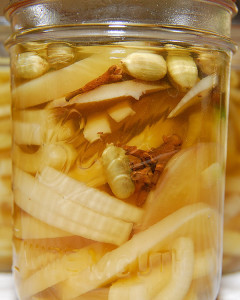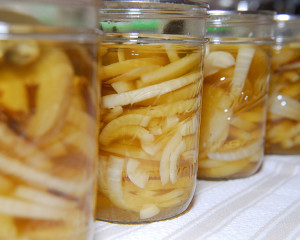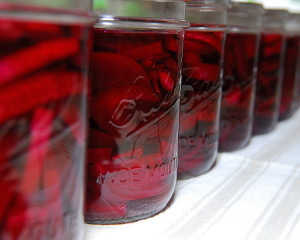We are fortunate to be able to grow beets most of the year here. A truly fresh beet, straight from the garden, has a wonderful, sweet, complex, earthy flavor. The natural sugars are enhanced in a fresh oven-roasted beet, which in my opinion is the best way to enjoy one. Although some of the milder beets, like Chioggas and Golden beets, are wonderful raw, shaved thinly over salads.
If you’re growing your own beets they’re likely to do so well in most gardens, that like us, you may suffer periods of ‘beet-burnout’. So if you need a break from beets, the logical thing to do with some of the extras is to put them up for those few potentially beet-less winter months.
These beets are highly aromatic, and have a wonderfully unique flavor. This recipe makes a small batch, perfect for adding a few exotically flavored beets to your pantry stores for winter.
Cardamom can be a little expensive, but this recipe doesn’t use a lot. I recommend only buying as much as you will need though, as it loses its potency very quickly when stored.

Cardamom pods should still have a greenish color, if they’re brown, they’re old, and should not be used
Yield: Makes 4 Wide-Mouth 16fl oz (500 ml) jars
1 lb (500 g) Beets, any variety
1 White Onion, sliced
3 Cups (500 ml) of reserved cooking liquid from the beets
1 1/2 Cups (375 ml) Apple Cider Vinegar, 5% acidity
1/3 Cup Sugar (84 g), or to taste
1 Tbsp Whole Cardamom Pods
1 Tbsp Whole Cloves
Pinch of Salt
Have 4 hot, sterilized jars (wide-mouth preferred) and their lids ready (see video below for tips on preparing your jars for canning).
Trim the green tops from the beets, leaving an inch of stem to prevent the color from bleeding excessively, and place them into a large saucepan. I find a 6-8 quart pasta pot with a strainer-insert works very well. Note, if using different colored beets, separate them by color into separate pans, and keep them separated throughout the pickling process! Add enough water to cover the beets by 2 inches, and bring them to a boil. Reduce the heat to medium-low, and simmer until the beets are just tender, 25-30 minutes. If your beets are variable in size, you may need to pull the smaller beets before the large ones are done to avoid over-cooking them.
Drain the beets, reserving 3 cups of the cooking liquid, and set them aside briefly to cool. When the cooked beets are cool enough to handle, peel them by simply slipping off their skins with your fingertips. Trim any remaining tops and roots, and cut the beets into slices 1/4 inch thick.
Divide the beets and onion slices evenly between the jars.
In a medium saucepan combine the reserved cooking liquid, vinegar, sugar, cardamom, cloves, and salt. Bring to a boil, stirring, until the sugar has just dissolved.
Ladle the hot vinegar mixture into each of the jars, evenly distributing the spices as much as possible, and leave 1/2 inch of head-space. Remove any air bubbles and adjust the head-space as needed. Wipe the rims clean and seal tightly with the lids.
Process the jars for 7 minutes in a boiling water bath. Leave the jars to stand undisturbed for 24 hours and then set them aside for at least 1 week before opening to allow the flavors to develop. Store sealed jars in a dark place for up to 3 months. If a seal has failed, store the jar in the refrigerator for up to 1 week.
Don’t have your own beets? It’s not too late to plant them for fall in this area, and there are a number of varieties worthy of trying beyond the standard red beets. If you can’t grow them, many Farmer’s Markets are absolutely brimming with them!
——————
The following helpful video demonstrates the boiling-water bath canning technique, including basic required equipment, and how to prepare your jars and lids for canning:
Visit the National Center for Home Food Preservation for more helpful information on canning home produce.














Dear Clare, I love beetroot hot as a vegetable, much preferring it that way than pickled. As you say, fresh and small they are absolutely delicious and how marvellous to have your own supply.
My cook/ housekeeper in Budapest makes the most delicious beetroot soup. I have to be careful to choose my clothes wisely when this is served for lunch!!
Wow! That looks like a fantastic recipe! I have yet to grow a beet that doesn’t taste like dirt – I meant LITERALLY taste like dirt. When I first started growing carrots, they too tasted like dirt. Not sure what it is, but I need to fix it because I do like beets.
Drooling.
Brilliant! You’re reminding me to get my seeds started. I bet the cardamom really makes it special. I usually do a quick pickle with carrots (or okra), apple cider vinegar, salt, sugar and chili flakes. Time to mix it up and try yours!
I love beets! I grow them in the fall and winter here in So CA.
I can’t wait to try your recipe for pickled beets. I may need to head to the farmers market on Friday and see if anyone has them so I can make them now. They would be so yummy on a salad.
Carla
Interesting…though I still have a lingering childhood suspicion of beets…
Those pickled beets look so beautiful. You must have a lovely stocked pantry. I have a fall planting of Chioggia just now getting their first true leaves, and a couple of Golden Beets that are struggling along in the shade.
Hello Clare, I’m another one who is drooling! I don’t think I’ll get as far as canning anything this year, as I’ve only a tiny crop of my first ever home grown beets. I’m yet to see if we will have any actual beets to harvest, but we have sure been enjoying the leaves!
To be honest, I have not given much thought to beets. Probably due to being forced to eat them as a child. But, you have convinced me to give them another try. I mean, I used to hate broccoli and now I love it.
PS. Thank you very much for your thoughtful comments on my latest posts.
Clare, I’m a huge fan of pickled beets from the store! I can only imagine how much I’d like a real, homemade version. My favorite kind of pickled beet is one I had in Europe at a restaurant selling Turkish cuisine — and you can be sure if I ever find that recipe, I’ll be in heaven.
Now I have one more reason to wish for canning equipment. 🙂 One day soon…
While I’m not a fan of pickled beets these sure do look good. Thank you for including the video on canning. I hope in future to try canning but am trying to read as much as possible in the meantime. Sadly none of my beets grew well this year, very disappointing. Will have to try again next year.
Clare, I love beets! They are tasty and good for us! I put them in the oven, unpeeled, and they stay there til they get softer and wrinkly. Pickled beets are not among my favorites, but I would gladly taste yours! Thank you!
That recipe for pickled beets sounds yummy. My mom was always pickling them and giving them away. I am the only one here who likes them though, so I didn’t plant any this year. I do love them roasted.
I can usually find green cardamom in a store that has Indian spices. They’re usually cheaper than what you find in the spice section of the grocery, though maybe not as potent.
I’m not a big eater of beetroot but I can relate to “burnout” as I sowed far too many salad leaves at the same time this year.
My dh would love that pickled beetroot Clare – I prefer them roasted.